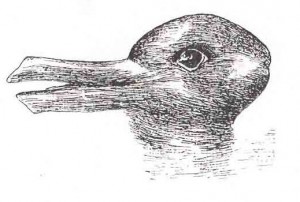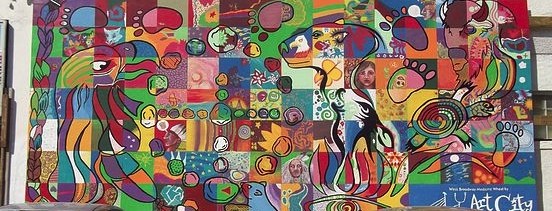Question 1: “…So, why does King create dichotomies for us to examine these two creation stories? Why does he emphasize the believability of one story over the other — as he says, he purposefully tells us the “Genesis” story with an authoritative voice, and “The Earth Diver” story with a storyteller’s voice. Why does King give us this analysis that depends on pairing up oppositions into a tidy row of dichotomies? What is he trying to show us?” (Paterson, “Lesson 2:2”)
Many of us have heard the saying “The world is not black and white – it’s grey”, or another variation on that theme, with truth replacing world.

Duck Rabbit Illusion by Joseph Jastrow.
King is trying to show us that dichotomies, as a seductive tenet and an “elemental structure of Western society” (King, 25), are restrictive and narrow conceptualizations. Spectrum and complexity – as alternatives to dichotomy – are presented by King as the “puzzle of the Gordian knot” (25). This puzzle is confounding to contemplate, and clarity is not forthcoming.
By presenting “The Earth Diver” story and the “Genesis” story side by side, he is using dichotomy to show how each story affects how someone (or some community, culture or people) see(s) the world. Dichotomy in this instance and within the context of King’s The Truth About Stories is useful as he is contrasting two worldviews/stories/cultures throughout the novel – those of the West and the First Nations. If he were to add more standpoints, the contrast provided by the dichotomy gets diluted, and perhaps loses effectiveness. However, the central idea provided by contrasting just two viewpoints can be applied to other cases as well, for the power of using the dichotomy is not to show how one viewpoint (First Nations or Western) is more or less valid than the other; rather, the dichotomy that King presents shows how whether we choose to follow a dichotomy and which standpoint we occupy affects our worldview.
In addition, I think that King’s utilization of dichotomy in displaying the two creation stories side by side calls for the reader to enact a critical distance when engaging with the two stories. By using the structure of dichotomy to display these two stories King is highlighting how being susceptible to using the structure of “easy oppositions” (25) can totally negate varied conceptions.
Is King’s use of dichotomy in presenting these stories a call to bridge the conflict implicit in believing one story over the other?
Lutz’s work examining myth understanding closes in on this idea as well. Lutz writes:
“Critically reading/hearing contact stories means engaging “myth understandings”. Rethinking contact stories means rethinking the relationship between history and myth and this, as Jonathan Hill has argued, should not just be an activity for scholars. It is a road to understanding our “own modes of mythic and historical consciousness” and how they differ from those in other societies…Something of the contact moment is absorbed and each of the parties is changed, sometimes profoundly, sometimes only by the addition of a story…” (Lutz, Myth Understandings, 15)
Lutz’s call to critically engage in myth understanding is a call to see how dichotomy was conceptualized in contact stories, and then to move past the dichotomy conception into the “contact situation” (32), or spectrum conception.
I’ve included the image above as an visualization of dichotomy and thinking (a little simplified, but so be it). It is an ambiguous image – an image that can depict two things. One of these things may be readily apparent, and the other may take longer to ‘see’, but once both are seen you cannot unseen them. You brain adjusts to the conflicting images.
John Ralston Saul wrote an interesting article which discusses the four barriers to paradigm shift within the context of bureaucracy working towards legislation which significantly tackles truth and reconciliation – I like a lot of what he is saying in the article, and think it speaks to much of what we are discussing in class. It’s worth the quick read!
Works Cited
King, Thomas. The Truth About Stories: A Native Narrative. Toronto: House of Anansi Press, 2003. Print.
